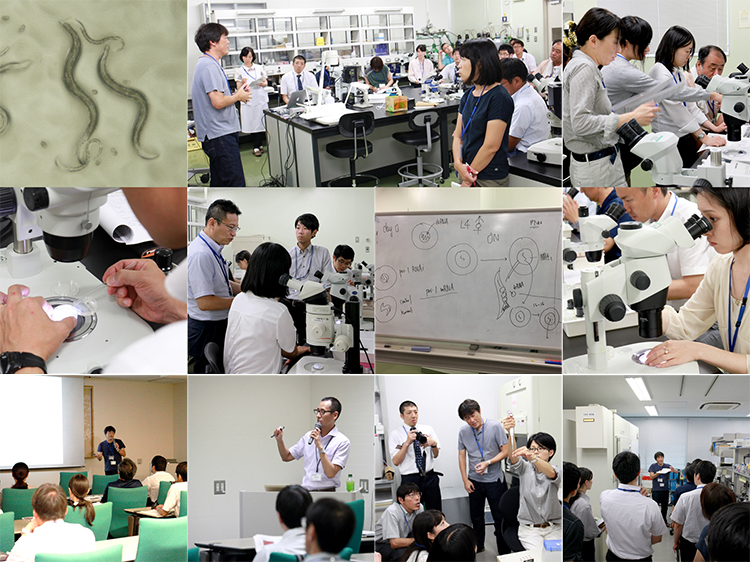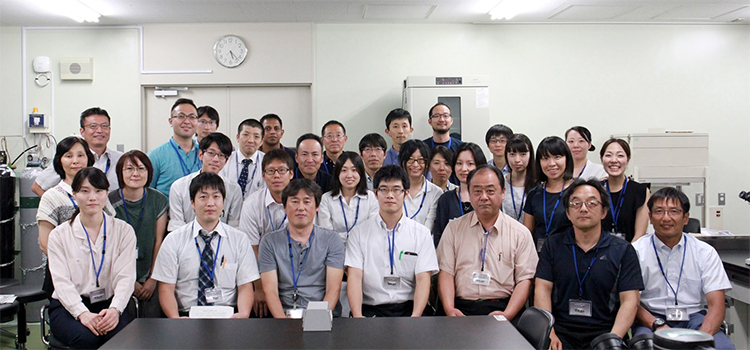
News and Announcements from the CDB
A hands-on workshop for high school biology teachers was held at the RIKEN Center for Developmental Biology (CDB) from August 7 to 8. The two-day workshop was co-organized by RIKEN CDB, RIKEN Quantitative Biology Center (QBiC), the Japanese Society for Developmental Biologists (JSDB), and the Hyogo Prefectural High School Educational Committee for Biology. A total of 22 teachers, mainly from the Kansai region, participated in the workshop, which this year focused on genetics research using Caenorhabditis elegans (C. elegans) as a model organism. The program was supervised and taught by Shuichi Onami, team leader of QBiC’s Laboratory for Developmental Dynamics.

Top and middle row: Scenes from the practical portion of the program.
Bottom row (from L to R): Talks by Team Leader Onami and Prof. Atsushi Kuhara, and teachers visit Onami’s lab to see experimental demonstration and experimental apparatus.
The nematode worm, C. elegans, is one of the major model organisms used in biology, and C. elegans research has contributed greatly to advance our knowledge of genetics as well as of developmental phenomena. Three past Nobel Prizes have been presented to groundbreaking findings made using C. elegans, from the mapping of the developmental fate of each cell in the C. elegans and revelation of mechanisms of programmed cell death (or apoptosis), to the discovery of RNA interference (RNAi) and being the first organism in which green fluorescent protein (GFP) was successfully introduced to visualize proteins inside a living body. The workshop program was designed to allow participants to learn and experience several exemplary experiments using C. elegans. The workshop kicked off with a lecture by Onami, who introduced C. elegans and their uses in biology, including the significant discoveries made using this organism. A special lecture by Professor Atsushi Kuhara of Konan University was also included in the program on the second day, who shared his group’s recent findings on thermotaxis in C. elegans in addition to introducing simple taxis-related experiments that can be done in a high school classroom setting.
For the practical portion, the teachers had the opportunity to examine different C. elegans mutants and also verify whether genes are passed onto progeny following Mendelian patterns of inheritance. They also tried their hand at analyzing phenotypes of worms following inhibition of gene expression using RNAi as well as analyzing live-imaging movies of embryonic development to try deciphering what gene was affected in the mutants, and observed samples of C. elegans expressing a certain GFP-tagged protein under a fluorescence microscope. Peering intently at the small worms through the microscopes, the participants all focused on completing each of tasks assigned to them, although some appeared to struggle with the technical aspect of handling the C. elegans. They also got a firsthand taste of real-life science, when some of the results they obtained were contrary to what was expected, and Onami led a fruitful discussion addressing possible causes of unexpected results. Finally, the teachers also had the chance to visit Onami’s lab to see demonstrations of RNAi injections and how live-imaging data is captured.

Group photo of the participants, Team Leader Onami and the support staff
Compared with other model organisms, C. elegans are relatively easy to care for, and can easily be used in the high school classroom. As an extension of this program, a few of the teachers who attended this workshop and are members of the Hyogo Prefectural High School Educational Committee for Biology will design a similar program geared for their own students to be held in November.
| Related link | Japanese Society for Developmental Biologists (JSDB) |
|---|---|
| RIKEN Quantitative Biology Center (QBiC) |